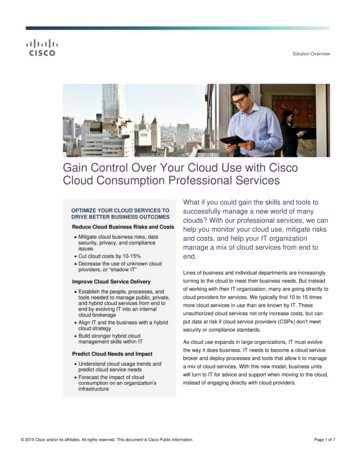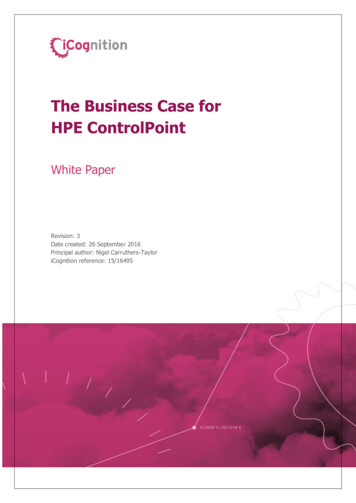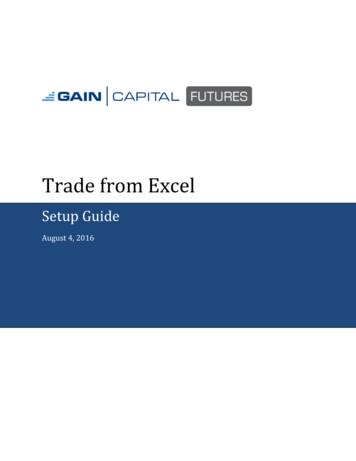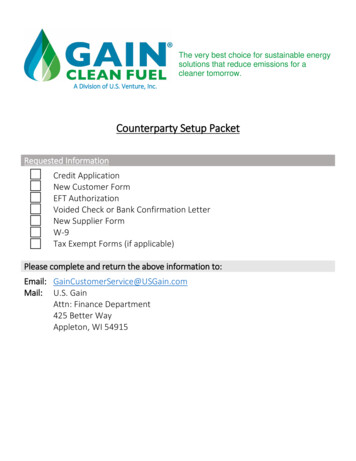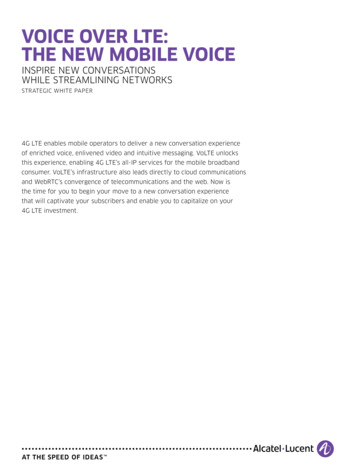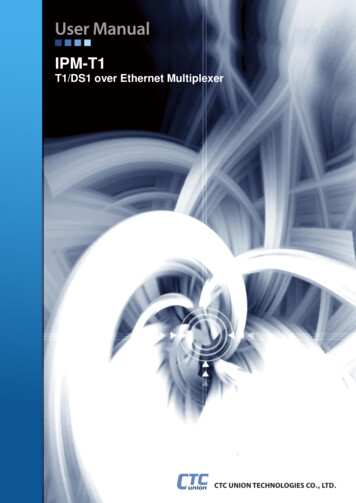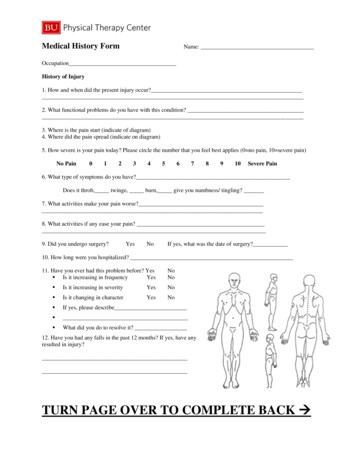
Transcription
BrochureGain control over allenterprise contentHP ControlPoint
Brochure HP ControlPointA better way to manage big dataMost organizations today store data in a number of business systems and informationrepositories. This practice has taken hold over the past two decades with the rapidadvancements in information-generating technology. But as the volume of data continuesto increase, organizations are facing significant business risk and loss of efficiency becausethey cannot effectively control the information contained in these siloed repositories—andsometimes are not fully aware ofwhat information they have.The unprecedented growth of data is mostly due to the increasing numbers of business andpersonal computing platforms, such as Microsoft Office applications and SharePoint, cloudcomputing, mobile devices, tablets, social networks, email, and line-of-business applications.If not properly governed, SharePoint is a prime example of how a collaborative businesssystem can contribute to big data, and potentially create dark data within information silosacross the enterprise.Understanding the value of data in active enterprise systems and legacy systems enables youto better manage your information footprint and associated storage costs through defensibledestruction of duplicate, obsolete, and trivial data. Identifying legacy data and establishing itsstatus as sensitive or secure information enables you to minimize the risk of accidental misuseand leakage.Identify, connect, and control data across enterprise systemsHP solutions help you to gain control over all information residing in systems across yourenterprise. HP ControlPoint and HP IDOL allow you to identify and connect your informationsiloes, and apply policy to this data to ensure its appropriate and ongoing management.HP ControlPointHP ControlPoint leverages HP’s Intelligent Data Operating Layer (IDOL) and connectorframework to identify, analyze, and control content across enterprise repositories. ControlPointenables classification, categorization, and policy application to content indexed by IDOL.ControlPoints executive dashboard provides valuable business insight into information; themes,locations and value.As a centralized information governance console for all connected data sources, ControlPointsimplifies the definition and application of policy regardless of data format or location. Thereis no need for source-specific policies, which become difficult to manage and unify acrossthe enterprise, and you eliminate the need for staff to learn multiple system tools and userinterfaces. ControlPoint’s role-based security allows the delegation of different tasks to reducethe likelihood of errors and bottlenecks.Figure 1: ControlPoint reporting dashboard with 2D cluster map showing hot zones.2
Brochure HP ControlPointControlPoint provides advanced, graphical visualization of information clusters based onmeaning. This graphical representation makes it very easy for executives to identify trends orpopular concepts and themes. Two-dimensional cluster maps show heat zones of informationgrouped by concepts, and clicking on the graph displays the underlying documents within thatzone. Three-dimensional spectrographs display how these clusters change over a period oftime. Clusters offer valuable understanding in the evolution of your enterprise information andare useful in training policies to apply defensible disposition management.ControlPoint’s executive dashboard presents the analysis of indexed data graphically withstatistical summaries and data categorization. This analysis allows you to understand thebreakdown of data types and categories across the enterprise or specific repositories. Arange of tools and reports support a policy-driven and compliant clean-up process, with thefollowing capabilities: Reports may be generated on items marked for deletion, Maintain audit trails of policy selection criteria and execution, Review and approve workflow processesThe ControlPoint dashboard serves as a collaborative hub, bringing together risk managers,compliance officers, and legal counsel to collaborate and enforce governance policies in onesystem. Navigational tools allow you to drill down to explore different areas of policy moduleapplication. For instance, an officer can learn how much data is potentially on hold across allenterprise systems, or what potential policy violations are occurring. Comprehensive reportingbrings critical transparency to your company’s compliance condition.Figure 2: ControlPoint dashboard with statistical summariesHP IDOLHP IDOL works at the core of ControlPoint to index all information, making it visible,transparent, and available to be analyzed, actioned, controlled, and governed. Informationsources such as file shares, SharePoint, and Microsoft Exchange are indexed through theIDOL connector framework. IDOL forms a conceptual and contextual understanding of thecontent, giving you the ability to index and analyze information from over 1,000 differentcontent formats. IDOL’s mature connector framework allows users to search across theentire enterprise using a web interface, providing an unprecedented view of all informationassets and enabling searches that are fully compliant with FRCP requirements. IDOL alsosupports eduction or entity extraction such as finding personally identifiable information (PII)in documents.Connector frameworkThrough IDOL’s connector framework, ControlPoint can access and analyze data from a range ofsources. Standard connectors provided with ControlPoint include: File shares Microsoft Exchange Microsoft SharePoint HP TRIM3
Brochure HP ControlPointFigure 3: IDOL connectors make information accessible across devices and applicationsBig Data &AnalyticsSocial MediaVideoSearch extsMobileCustomerExperience zationSearch basesMail serversCRM/ERP/BILDAPGet more from your data and reduce footprint, risk, and costInformation contained in multiple systems and repositories provides little insight into businessperformance and themes if it is not managed in a holistic manner. Siloed information providestactical value to a small segment of the overall enterprise, but rarely delivers strategic value toexecutives or the enterprise as a whole. The ability to report on and display an organization’sinformation evolution is invaluable for future strategy and performance.The emergence of dark dataDark data is the data that you may not know you have. This currently unmanaged, often unknownelectronic information resides in various repositories across the organization. Dark data is mostlyhuman-readable, unstructured, unindexed, inactive, and orphaned. Proliferation of dark data canresult from the “Bring Your Own Device” (BYOD) phenomenon, along with the continuing explosionof big data with new unstructured data types such as audio, video, and social media. In thisscenario, information governance challenges arise when information that is generated and storedon mobile devices, social platforms, file-sharing services, and SharePoint goes unmanaged.Because so little is known about this dark data, it places the organization at risk.Identify redundant, obsolete and trivial dataThe information footprint of an organization can be significantly reduced to provide measurablereturns, if redundant, obsolete, and trivial data can be identified within system repositories.Redundant data consists of duplicates in the form of unauthorized copies of documents,emails, records, or database information residing in file shares, SharePoint sites, mail systems,and databases.Obsolete data consists of information that is no longer in use, or is out of date. Whendetermining whether data is obsolete, you can identify its creation date, last modified date, oraccess date and then assess this information in conjunction with an appropriate retention policy.Trivial data is determined by file type, where the file type has no content value, such asexecutables, system files, and thumbnails.Figure 4: ControlPoint dashboard showing the ratio of redundant, obsolete and trivial data.4
Brochure HP ControlPointLegacy data clean-upOrganizations often look to legacy data cleanup to address a number of information governanceissues. The process may be undertaken as a standalone activity to address a specific problemsuch as part of an onboarding process for applications and information acquired during mergerand acquisition activities. Legacy data clean-up may also be undertaken as part of an ongoingbusiness project to improve efficiency and reduce information footprint. Another use is to conductlegacy data clean-up to gain greater insight into data holdings and the categories they fall into,aiding in the establishment or improvement of information governance practices.ControlPoint’s Legacy Data Clean-up component provides opportunities for analysis and datatagging in legacy repositories to ensure policy is applied and appropriate action is taken toensure defensible disposition or ongoing management.Analysis is conducted on a range of data attributes including date fields, file properties (typeand size), creator, category matching, custom fields, and duplicate assessment against definedmasters. ControlPoint’s Legacy Data Clean-up process consists of five stages moving fromidentification through to action and clean-up.StageProcessIdentifyand index Identify data sources--Index at meta data level (redundant, obsolete, and trivial)--Index at content level (deeper analysis, insight, data relevance)Analyze Statistical summaries (% of redundant, obsolete, and trivial)--Data creation and volumes over time--Categorization of data based on content index (concepts and context)--Personally Identifiable Information (eduction)Organize Identify information clusters and common content patterns--Data groupings and categories--Apply policy according to categorization and classificationReduce Policy-driven defensible disposal--Audit logs and reports to support compliant processesManageandmigrate Data identified to have business value and relevance migrated and managed under theorganization’s Information Governance plan--Declaring documents into the records management system--Secure moves and holds--Migration to tiered storage or repositories--Ongoing application of policy to new data based on established and trained categoriesEnsure information governance and control acrossenterprise systemsInformation silos and non-complianceThe risk of non-compliance can be high for organizations living with information silos orSharePoint site proliferation, which can easily lead to the existence of legacy data and darkdata. Approaching each challenge separately is costly and leads to a disjointed informationgovernance implementation that is likely to have gaps.Through HP IDOL’s unified and consolidated view and connectors, ControlPoint can applystandardized policies from a central policy engine. The data is effectively managed through acentral information governance console.ControlPoint offers policy-driven classification, auto-declaration, manage-in place capabilitiesand seamless integration with HP TRIM records management software to help you bringinformation under control within a robust information governance framework.Reduce risk and meet the demands of regulationMeeting internal governance and regulatory compliance requirements and responding tolegal discovery, external investigation, and audit inquiries are both business obligations andchallenges. Non-compliance is a risk that may result in financial penalties, interruption to yourbusiness operations, and negative publicity. To meet compliance obligations and be preparedfor legal discovery or investigation, organizations should adopt a proactive approach toinformation management. When you work proactively, it is much easier to foresee areas of riskand address these before they become real problems.5
Brochure HP ControlPointRecords management & defensible dispositionMany organizations keep their content well beyond its expiration date or inadvertently deletevaluable business documents. These information management practices may result fromdisconnected information silos, a lack of understanding about what content exists and where,poor policy application and enforcement, and a lack of information security. ControlPointallows you to manage or dispose of content in place for subscribing systems or declarecontent in these systems as records and move in to HP TRIM for their ongoing, secure andcompliant management.Seamless integration with HP TRIM electronic document and recordsmanagement softwareControlPoint’s seamless integration to HP TRIM electronic document and records managementsoftware facilitates robust, compliant records management for all declared business records.ControlPoint’s auto- declaration of records simplifies the flow of content from enterprisesystems into HP TRIM. HP TRIM manages, secures, and provides access to all corporate recordsin business context, ensuring authenticity, integrity, and reliability.ControlPoint with HP TRIM provides full document and records management functionality,automating the retention and disposition of information. ControlPoint provides a range of auditlogs and reports out of the box, allowing you to keep a defensible history of policy changes aswell as the effects of policy application to managed content. These user-driven or automatedreports help you monitor the application and effect of policies on your information. HP TRIMmanages records according to applied disposition schedules and event triggers, ensuringsecure management and defensible disposition.Increase efficiency and elevate productivitythrough automationAs the volume of electronic content continues to grow, it is critical for businesses to adoptan information governance solution that does not rely exclusively on the manual efforts ofusers and administrators. ControlPoint effectively automates the consistent application ofpolicy to content based on the conceptual understanding of information in a multitude of fileformats. Additionally, you can use document/location metadata as part of policy assignment.ControlPoint also enables you to automate information policy enforcement and audits.Train ControlPoint categoriesThe ability to train ControlPoint categories based on existing IDOL categories or records withinHP TRIM removes much of the burden of having users manually create or map categories. Aselection of documents from system repositories is used for training and benchmarking, ensuringcategories are based on meaningful concepts and real business context. This capability improvesthe efficiency and accuracy of categories and the application of policy to content.Draft categories can be prepared without affecting documents in production systems. Thesecan be refined and tested to determine the impact they are likely to have on enterprisedocuments. A category may be refined by adjusting the weighting of a term, the selectionthreshold, or by adding field text. This can be done individually or in combination. Oncerefinement is complete, the category can be published, making it available for use in automaticpolicy execution against content managed by ControlPoint.Automate categorizationCategorization is critical to the application of policies. Whereas traditional collaborationand ECM systems rely upon users to categorize and tag information on an individual basis,ControlPoint leverages IDOL to analyze information, arranging it into self-similar groupsor clusters and leveraging IDOL by matching the data against trained categories. Throughduplicate and near-duplicate identification, storage costs are minimized, while documentsidentified as records can be declared into the records management system (HP TRIM). Userscan file content using a single click or content can be automatically classified based on rules andIDOL’s understanding of the concepts and context contained in the documents.6
Brochure HP ControlPointAutomate policy-driven classificationOnce data is categorized, policies can be applied to the data for ongoing management. Policiescan be created with keywords, metadata, and/or example documents using a simple Webbased, wizard rich dashboard. Policy creation is intuitive and allows automatic enforcement.Policies can be linked to the classification scheme within HP TRIM, ensuring the appropriateretention and disposition schedules are applied to declared records.ControlPoint enalbes you to: Automate policy application governing all aspects of the information lifecycle, includingdeletion prevention, storage management, and ultimately disposition management byapplying meaning-based policies at data creation Leverage a web-based, non-IT centric dashboard to create policies De-duplicate data across repositories to minimize storage costs and reduce discovery timesManage-in-placeControlPoint provides the flexibility for users to perform specific actions on content in-place.These in-place capabilities simplify the management of enterprise content according tobusiness value and lifespan. The ControlPoint client makes it easy to identify and categorizecontent from any subscribing system, then based on policy, this content can be moved into arecords management system (HP TRIM), the archive, or indicated as ready for destruction.ControlPoint leverages IDOL indexes and categories to apply policy to information via theconnector framework. The policy can dictate a number of actions to be carried out, including: Hold Release hold Copy Secure copy Move (between repositories) Apply tags Delete Declare record Initiate an HP Process Automation (APA) workflowContent that has not been accessed for a defined period of time can be moved to more costefficient storage, eliminating the need to license costly SQL servers in SharePoint environments(inactive SharePoint sites) and alleviating the strain on network resources. Both of thesecapabilities can bring substantial savings to your organization.Email that falls under an automatic clean-up rule can be checked to see if it matches arecords category before deletion, minimizing the risk of important information being deletedinadvertently if the user hasn’t actively declared it as a record. The efficient managementof these information platforms throughout their lifecycle greatly reduces storage andinfrastructure costs.Summary of key benefits Gain visibility and understanding of business risk associated with information stored inenterprise systems. Automate compliance, legal hold, and disposition management based on policy and theconceptual understanding of information across various file formats. Perform legacy data cleanup and defensible disposition by :––Identifying, categorizing, and classifying content in enterprise information silos Inventory content based on business value and lifespan to facilitate appropriate management Set a policy to drive secure management of business records in the records managementsystem or to defensibly dispose of redundant, outdated, and trivial content7
Brochure HP ControlPointAbout HP AutonomyHP Autonomy is a global leader in software that processes human information, or unstructureddata, including social media, email, video, audio, text and web pages, etc. Autonomy’s powerfulmanagement and analytic tools for structured information together with its ability to extractmeaning in real time from all forms of information, regardless of format, is a powerful toolfor companies seeking to get the most out of their data. Autonomy’s product portfolio helpspower companies through enterprise search analytics, business process management andOEM operations. Autonomy also offers information governance solutions in areas such aseDiscovery, content management and compliance, as well as marketing solutions that h
ControlPoint’s auto- declaration of records simplifies the flow of content from enterprise systems into HP TRIM. HP TRIM manages, secures, and provides access to all corporate records in business context, ensuring authenticity, integrity, and reliability. ControlPoint with HP TRIM pro
